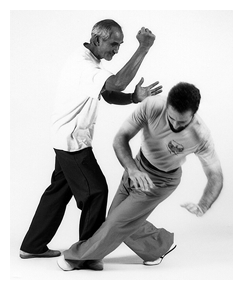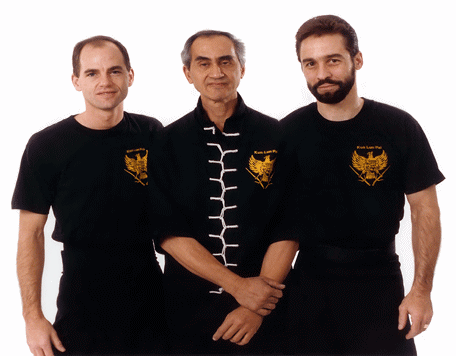
Looking at him, you would not think this slender, gentle-looking man capable of even defending himself, let alone meting out punishment, but beneath his smiling face and disarming manner beats the heart of a kuntao master. De Thouars comes from a family whose martial art heritage goes back to before the turn of the twentieth century. His grandfather, great-uncle, father, uncles, brothers, and even his wife, are all martial artists. With that kind of martial art heritage, one would have expected de Thouars to pursue his family's art of pentjak silat serak, but this was not the case.
Born in Indonesia on January 9, 1936, Willem de Thouars was the fourth (and smallest) of six
brothers. His brothers – all big men – practice the family art, an art that is well suited to
their size. Willem, on the other hand, is built nothing like his barrel-chested brothers.
Because of his slight build, de Thouars felt that the family art would not work as well for him.
Add to this his admittedly rebellious nature, and its little wonder that Willem chose to travel a different
path. Instead of studying the family's system, de Thouars pursued another,
World War II saw de Thouars, along with many Indonesians, in Japanese internment. It was during this time that his instructor, Liem Ping Wan was killed. However, the death of his teacher did not mean an end to de Thouars' training. Before his death, Liem had already introduced the young de Thouars to three of his "finished" disciples, setting the stage for him to continue his formal training with them. From 1946 to 1953 de Thouars trained with Tan Tong Liong, studying his internal-external system of que moi shantung kuntao. In 1953, Tan Tong Liong sent de Thouars to Willem Chen, with whom he trained until 1954 in external kwantung po kwa zen kuntao. Like Tan Tong Liong before him, William Chen, when he felt that de Thouars' training had progressed sufficiently, sent him to the third of Liem Ping Wan's disciples, Buk Chin. Under Buk Chin, de Thouars studied tai keh (t'ai chi) and pa-kwa zen kuntao, completing his training with him in 1956. This, however, was only part of the training de Thouars received during these early years. In 1949, while still under the tutelage of his kuntao teachers, de Thouars studied Sikwitang and Kendang silat from Raden Sunario and Mas Atmo. He trained with them for seven years. Further, from 1950 to 1953, de Thouars studied samull petjut silat (a combination of petjut silat and kuntao) from a Muslim priest named Raden Djuran Hadji Samul. De Thouars' formal instruction in these silat systems is directly responsible for some 30 percent of the principles, forms, and techniques he teaches in his system of kun lun pai – wu kung kuntao – ratu duri silat. The other 70 percent of de Thouars' system is traditional kuntao. Kuntao Chinese kuntao is a punishing art characterized by tearing and breaking. The opponent's extremities, for example, are attacked with devastating blows – punches and elbows to break down his defenses and open him up for an all-out assault. (De Thouars often refers to this as "torturing" your assailant.) Kuntao stances tend to be wider and deeper than silat stances, with considerable emphasis being placed on seating. (An example of the seating principle is dropping your center of gravity by picking up your feet and letting gravity suddenly lower or deepen your horse stance.) Seating serves many functions, but a major one is to bring an opponent down, break his balance, or otherwise bring him to his knees. Silat players also believe in bringing down their opponents, but they do it with combinations of sophisticated sweeps coupled with counter-balancing strikes. Also, silat, while containing circular moves of its own, is generally more linear than kuntao (the circularity in kuntao was one of the things that influenced de Thouars' decision to study the art). Kuntao Tradition One of the strongest traditions in kuntao is the tradition of change. Initially, I believed that kuntao masters always sought function over form and consciously made changes as needed from one generation to the next. This, it seems, may not be the case. According to Donn Draeger (Draeger, 1992,164), kuntao masters always taught less than thay knew to protect their superior status. This practice left the dedicated student with the task of filling in the gaps. Regardless of the masters' motivation, the upshot of this has been the constant upgrading of the art as each succeeding master added to the original system. 1 Li Po Chang took what he learned and synthesized it into his own system – Po Kwa Zen. Liem Ping Wan, Li's disciple, further refined the art he received into a system he called Chuan Chu Shing I. Liem Ping Wan taught three "finished" men: Tan Tong Liong, William Chen, and Buk Chin. Each expanded and refined the art in different directions resulting in Tan Tong Liong's internal-external Shantung kuntao, William Chen's external Fuekchin kuntao, and Buk Chin's internal Hokkien kuntao. Following that tradition, de Thouars balances the need to keep alive traditions and traditional training methods with the needs presented by today's environment. Kun Lun Pai In some circles, it is almost a dirty word (certainly it has been misused and overworked), but eclectic is precisely the word that belongs here. By definition, eclectic means "selecting what appears to be the best in various doctrines, methods, or styles." Through his studies, de Thouars has developed an eclectic system that borrows from the many martial influences Indonesia has produced. Fusing kuntao and silat, he has produced a highly functional and effective kuntao-silat self-defense method he calls kun lun pai. Willem de Thouars describes kun lun pai as an internal-external system. Recognizing the fact that Americans generally are not drawn to internal systems, preferring the more physical, external arts, de Thouars starts students in the basic jurus (practice sets and forms) of silat. After a thorough understanding of these principles, the student is taken into external kuntao (from the Shaolin side of Chinese martial arts). This meets the need Americans have for getting "physical" and provides a suitable platform for advanced internal training.
Willem de Thouars has approached modern-day kuntao with a broadmindedness becoming its tradition, and the result
has been a vitality and an ensured continuation of the principles his teachers received and passed on to him.

|
|
Notes and References
|
|
©Copyright Bob Orlando, 1991-2016 All rights reserved. |
http://www.OrlandoKuntao.com
E-mail: Ron@OrlandoKuntao.com |
Last update:
Aug. 6, 2016 by Bob Orlando |